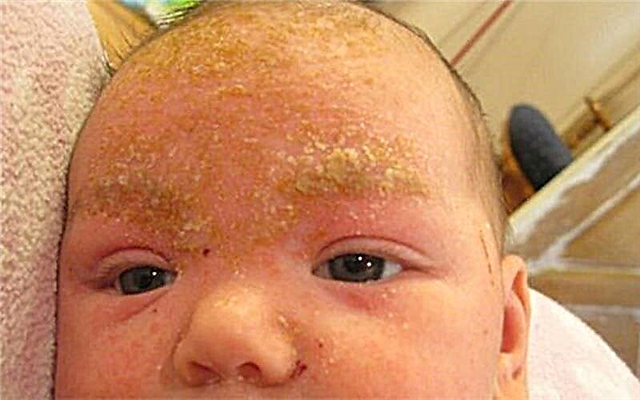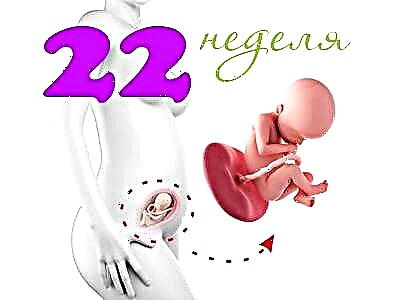
Nasonex is called one of the most effective local hormonal drugs. It is often prescribed to adults with various forms of the common cold, especially if the disease is of an allergic nature. But is such a drug allowed for the treatment of children, how does it affect the child's body and how can it be dangerous for babies?

Release form
Nasonex is produced in only one form, which is a spray for use in the nose. It is dosed and is sold in two volumes:
- 10 g bottle containing 60 doses. One box contains one such polyethylene bottle equipped with a dispensing device.
- A bottle weighing 18 g, inside which there are 120 doses of medicine. One pack can contain 1, 2 or 3 such plastic bottles with a dispensing device.

Inside any of the vials is a white suspension. In such forms as tablets, syrup, capsules, ointment, drops and others, Nasonex is not released.
Composition
Nasonex works by providing a substance called mometasone furoate. This compound is represented by a monohydrate and is micronized. From each dose of the drug, the patient receives it in the amount of 50 mcg. Additionally, the suspension contains dispersed cellulose, benzalkonium chloride, citric acid and glycerol, as well as purified water, sodium citrate and polysorbate 80. Such substances are needed to keep the medicine in a liquid form and prevent spoilage.

Operating principle
Mometasone is a glucocorticoid hormone, so it has anti-allergic and anti-inflammatory effects. When using a spray in doses that are recommended in the annotation, its active substance acts only locally and no systemic effects occur (it is absorbed in an amount of less than 1%). The use of Nazonex leads to:
- inhibition of the release of substances, which are inflammatory mediators;
- increased production of lipomodulin, as a result, the metabolism of arachidonic acid is inhibited, which also affects the activity of inflammation and allergic reactions;


- preventing the accumulation of neutrophilic leukocytes at the site of inflammation, due to which the exudate is reduced, the movement of macrophages is inhibited, and granulation and infiltration are reduced.
Due to these effects, Nasonex not only eliminates the inflammatory process, but also inhibits allergic reactions (especially of the immediate type). Thanks to the glycerin in the composition, the suspension does not provoke drying out, but, on the contrary, moisturizes the nasal cavity, which contributes to the regeneration of the epithelium.

The therapeutic effect of the drug in most patients begins to manifest itself 12 hours after the first use of the spray. A persistent effect of therapy develops by the 5-7th day of drug use. Moreover, even with prolonged use, addiction to mometasone does not develop.

Indications
Nazonex is prescribed:
- With year-round allergic rhinitis.
- With the seasonal form of allergic rhinitis.
- In acute sinusitis (together with antibiotics or antiviral drugs, if the inflammation was provoked by ARVI).
- In the chronic course of sinusitis during an exacerbation of the disease (in combination with other drugs).

- With a moderate and mild course of acute rhinosinusitis.
- To prevent severe or moderate seasonal rhinitis caused by pollen allergens.
- In the presence of polyps in the nose (the medication is prescribed only for adults).
From what age is it used?
The drug is contraindicated in babies under 2 years old, and from the age of two it is prescribed only for the treatment of rhinitis. For prophylactic purposes, as well as for inflammation of the sinuses, Nasonex is recommended to be used in children from only 12 years old, and for nasal polyposis, the drug is not prescribed until 18 years old.

Contraindications
The spray should not be used in children with hypersensitivity to any of the suspension components. Also, the medication is harmful to patients who have recently undergone surgery in the nasopharynx area or have injured the nasal mucosa. In such situations, the drug is not prescribed until complete healing.

Patients with tuberculous lesions of the respiratory system, active bacterial or fungal infection require attention from the doctor when using Nasonex. In addition, the agent must be injected carefully and for serious viral infections, including infection with the herpes simplex virus. The question of the use of the drug in children with local changes in the mucous membrane of the nasopharynx is decided individually.
Side effects
The use of Nazonex in children sometimes provokes the appearance of:
- headache;
- bleeding from the nose;
- sneezing;
- irritation of the mucous membrane.
In adolescents, the spray may occasionally cause a burning sensation in the nose, ulceration of the mucous membrane, or pharyngitis. In isolated cases, the drug provokes bronchospasm, anaphylaxis or other allergic reaction, and also disrupts the sense of smell and taste. Increased intraocular pressure and perforation of the nasal septum are called extremely rare side effects during Nasonex therapy.
A very long use of the drug can theoretically cause the development of such side effects as growth retardation, fungal infection of the nasopharynx, Cushing's syndrome, glaucoma, sleep disturbances, aggressive behavior and other problems. However, studies have shown that even long-term treatment with a spray does not provoke systemic effects, because the drug is absorbed in very small quantities.


Dosage and administration
Instructions for use. For a child aged 2 to 11 years, the medicine is prescribed one inhalation, first in one nostril, and then in the second. The drug should be used once a day, since the total dose of the drug per day for patients under 12 years of age is 100 mcg of mometasone. To properly spray the suspension for small children, adult help is required:

- Before first use press the dispensing nozzle several times to create splashes. The same actions are needed if the spray has not been used for more than 14 days.
- Tilting the child's head slightly to the side, the end of the nozzle is inserted into the nostril and the dispenser is pressed once. Further, the medication is also injected into the second nasal passage.


- Before each use of Nazonex the bottle must be shaken so that the suspension entering the nose is homogeneous.
- If the medicine is used for a long time, The dispensing nozzle should be periodically cleaned by rinsing its tip and protective cap in warm water. When these elements are dry, they are carefully attached back to the bottle.
For adolescents 12 years and older with allergic rhinitis, both for treatment and for prophylaxis, 200 μg of mometasone per day is prescribed, which corresponds to two inhalations of Nasonex in each nasal passage. The spray is applied in such a dosage once, and when a therapeutic effect is achieved, the dose can be reduced to 1 inhalation in each nasal passage once a day (only 100 μg of the active compound). In the case when the use of 2 inhalations does not provide relief from nasal congestion, itching and other symptoms, it is possible to increase the daily dosage to 400 mcg of mometasone, that is, up to four inhalations of the drug in each nasal passage.

For sinusitis and rhinonusitis in a child over 12 years old, the medication is prescribed in a single dose of 100 mcg in each nostril (two inhalations at once) twice a day. In total, for the treatment of such diseases, the patient receives 400 micrograms per day, but if ineffective, this dosage can increase to 800 micrograms (four inhalations in each nostril twice a day).
The duration of the use of Nasonex for each child is determined individually. In some patients, the course of treatment lasts several weeks, and for others, the spray is prescribed for several months. It all depends on the diagnosis and the body's response to therapy
Overdose
Exceeding the dose of the spray one or more times often does not affect the patient's health in any way and requires only observation, since the systemic bioavailability of mometasone is very low. However, prolonged excess of the dosage of Nasonex or a combination of such an agent with other glucocorticoids can cause adrenal suppression.

Interaction with other drugs
Studies have shown the safety of the simultaneous use of Nasonex and loratadine preparations. The manufacturer does not mention the incompatibility of the spray with other products.

Terms of sale and storage
Acquisition of Nazonex at a pharmacy is possible only with a prescription from an ENT doctor, pediatrician or other specialist. The average price of a 60-dose bottle is 440-450 rubles, and for a bottle weighing 18 grams you need to pay from 700 to 800 rubles.


It is recommended to keep the spray at home at a temperature +2 - +25 degrees, avoiding freezing or overheating of the suspension. The shelf life of Nazonex is 2 years old and marked on the box. After its completion, the medicine should be discarded.
Reviews
There are a lot of positive reviews about the treatment of children with Nasonex, both from doctors and from parents. Pediatricians and ENT doctors (including Dr. Komarovsky) call such a spray effective and safe. Mothers also confirm that the medication is effective for allergies and relieves the condition of a child with a runny nose. Although the cost of the drug is called quite high, doctors say that Nasonex works better than analogues and is more studied, therefore it is preferable for the treatment of small patients

Analogs
To replace Nazonex with a runny nose in children, the doctor may prescribe another agent based on mometasone, for example, Nosephrine or Desrinitis... Such medicines are also presented as a dosed nasal spray and contain 50 μg of mometasone furoate in one dose. These drugs have the same indications, age restrictions and possible side effects as Nasonex. Moreover, their cost is much lower, so such sprays are chosen when they are looking for an inexpensive analogue.
In addition to drugs containing mometasone, other local glucocorticoid agents can be used in the treatment of rhinitis, for example:
- Avamis. The action of such a spray is provided by fluticasone furoate. The drug is prescribed for children over 2 years of age with allergic rhinitis.
- Fliksonase. This nasal spray also contains fluticasone, but in the form of propionate. The medication is used in the treatment of lingering rhinitis provoked by allergens, prescribing it from the age of 4.
- Nazarel. This metered spray is another preparation of fluticasone propionate and, like Flixonase, is used in young patients over four years old.
- Dexamethasone... ENT doctors can prescribe such eye drops in the form of nasal drops, often combining them with other drugs (antibiotics, antiseptics, vasoconstrictors, etc.), creating "complex drops". The use of Dexamethasone in the nose is considered an emergency and is not recommended without a doctor's prescription.
- Polydex with phenylephrine. This combined agent, including dexamethasone, two antibacterial agents and an adrenergic agonist, is prescribed for children from 2.5 years old. It is used for rhinopharyngitis, rhinitis, sinusitis and other sinusitis, if bacteria are the cause of such diseases. Separately, the drug Polydex is produced, used for otitis media.
- Nasobek. Beclomethasone is the main ingredient in this spray. The medication is prescribed for children with rhinitis caused by allergies from the age of 6.
Doctor Komarovsky will tell you how to treat a children's rhinitis in the video below.



